We had some reservations about doing the Gibb after hearing countless horror stories of the toll it takes on man and machine but we are thankful to those who encouraged us to do it. The Gibb was absolutely amazing and one of the highlights of our trip so far.
One reason is that we travelled the entire length of the Gibb with two families we had met previously (one at Karijini and the other at Cape Leveque). It was fantastic sharing this time together and with a total of 8 kids it was a lot of fun!
Below is a summary of our adventures along the Gibb River Road:
Windjana Gorge:
Leaving Broome we travelled to Derby (where we filled the Cruisers fuel tanks to overflowing) and then onto the Gibb River Road. The road soon turned to gravel and after letting our tyres down to 25-30psi we made good progress. After about 150km we came across an older couple on the side of the road. We pulled over and found that they had a flat tyre earlier in the day and now had a blow out on their spare. They did have a puncture repair kit and soon had the first tyre holding air again (this is why most people travelling the Gibb carry 2 spare tyres). As the sun set behind us we arrived at our first stop at Windjana Gorge National Park.
Although not as dramatic as the gorges we had explored at Karijini, Windjana Gorge was spectacular with its orange and black cliffs in stark contrast to the surrounding grass land.
It is also one of the best places in the Kimberley to see fresh water crocodiles in the wild. The kids counted 50 in one pool alone.
Tunnel Creek:
Only 30km south of Windjana is Tunnel Creek National Park. As the name suggests, a creek has carved its way through a mountain range, which, during the dry season you can walk (or wade) through. It was quite an experience leaving the hot, dry air at ground level and descending into the dark, cool tunnel.
The tunnel itself is about 800m long and is pitch black in the middle. On several occasions we had to wade through the creek only to discover it was home to a couple of cave dwelling fresh water crocodiles, much to the excitement of the kids.
Other than the crocodiles, it seems that a lot of other creatures use the tunnel to escape the heat including bats, spiders and snakes (Nath found a snake skin part way along the tunnel).
After two nights at Windjana we hit the road again heading for a camp spot called Silent Grove. The road was still in great condition with only minor corrugations and a few small river crossings.
There is not much other that bush and a small creek at Silent Grove but the main attraction is Bell Gorge. After setting up camp we drove the 10km to the gorge trail head and after a 30 minute hike through the hot, dusty bush Bell Gorge with it's water fall and deep pool was a welcome sight.
The three families had a great time cooling off, swimming under the water fall and basking on the solar heated rocks.
In the cool of the afternoon we set off back to the cars using some unconventional creek crossing techniques in order for the kids not to have to take off their boots!
Upon returning to camp we cooked dinner over the camp fire and then reclined to marvel at the heavens above.
Galvin Gorge:
After a relaxing night at Silent Grove we packed up and got back on the road. Given the Gibb passes through a number of unfenced cattle stations it is not uncommon to come across these guys standing in the middle of the road and they are not in a hurry to move!
At midday we stopped at Galvin Gorge for a quick swim. The gorge is only a short walk from the road and is very picturesque with its clear round pool, water fall and Boab Tree perched on top of the cliff.
It also had some equally beautiful locals!
After enjoying the refreshing swim, jumping from the cliff and a rope swing we headed back to the car for lunch and a short drive to Mt Barnett Roadhouse. This is the only place since Derby that has Diesel so we filled up the tanks ($1.99 / litre).
Manning Gorge:
Only 7km from the roadhouse is Manning Gorge camp ground, our stop for the night.
The gorge is about a 1 hour hike from the camp ground, something we planned to do the next day, but there is a fantastic water hole right at the camp ground... but before we could go for a swim we had to do some washing (good job Em)!
We then headed to the water hole and spent the afternoon talking to fellow travelers and swimming in the clear, cool water.
The next morning we rose early to beat the heat and headed off to Manning Gorge. At the start of the hike we had to cross a river on a hand drawn punt which was quite the balancing act... we all made it dry to the other side.
The 1 hour hike is hot and rocky but on arriving at Manning Gorge the sight is spectacular.
We spent several hours at the gorge with the highlights being swimming under and jumping off the waterfall! Nath, Sarah and Em loved it!
Barnett River Gorge:
Given it was very hot we spent most of the day swimming and then left Manning Gorge in the cool of the late afternoon. It is great to drive the Gibb at this time of day as there is less traffic (and less dust) and with the sun setting behind us, bathing the surrounding escarpments in a yellow and orange hues it is a wonderful view.
We only managed to travel 29km to Barnett River Gorge before sunset. We camped on the side of a dry river bed under the shade of a massive Boab Tree.
The next morning we hiked to Barnett River Gorge, a 40 minute hike across the dry rocky escarpment. This is one of the lesser known and visited gorges along the Gibb and it felt like we had the whole place to ourselves.
Ellenbrae Station:
Again travelling in the afternoon we had planned our next stop to be at Home Valley Station. However, part way through our travel we came to the turn off to Ellenbrae Station. This too is one of the lesser known and visited Stations and after some quick deliberations we decided to drive in the 10km to look around.
Within 1 km we came to a small water crossing. I waded across first to check the depth and was glad I did as there was a large "sump busting" boulder sitting right in the middle!
When we arrived at Ellenbrae we were pleasantly surprised by the lush, well kept gardens and the rustic buildings and outhouses.
Talking to the care takers we learnt that Ellenbrae is a 980,000 acre station running about 4000 head of cattle and is owned by a family in Melbourne (the Grollo family).
We set up camp at Ringers Campground which had the must beautiful rustic amenities we have ever seen. The building was built from rough cut rock and contained a toilet, shower and bath! The water was heater by a "Donkey" hot water system which we had to stoke and add wood before hand. The kids had a well needed bath which was a real treat.
That night Nath and I collected fire wood and after a beautiful dinner settled down around the best camp fire (the fire wood up here is amazingly dense and dry). After another long day Em didn't last too long!
Home Valley Station:
Leaving Ellenbrae Station we travelled the remaining couple of hours to Home Valley Station. Along the way we passed over the Durack River and climbed over the Cockburn Ranges and then descended to Home Valley Station.
Home Valley is located on the banks of the Pentecost River and is an indigenous owned cattle station which is set us for tourists and used as an indigenous training facility.
At Home Valley we came across our first Cane Toads which have been steadily moving across Australia and are unfortunately now entering the Kimberley. For those that don't know the Cane Toad was introduced into Queensland to control the Cane Beatle which was eating the Sugar Cane. Unfortunately the Cane Toad had no interest in eating the Cane Beatle and set about eating our native reptiles and poisoning any animal that ate it (Cane Toads have poisonous glands behind their eyes powerful enough to kill a saltwater crocodile).
Liz and the kids saw this as their opportunity to help with the eradication and caught and disposed of many toads.
Elquestro Station:
Leaving Home Valley bound for Elquestro Station, the Gibb had one last challenge for us... crossing the Pentecost River. This was by far the longest and deepest water crossing we had attempted to date and it was with much excitement that we approached the river.
We sent Liz across first with a couple of German tourists so that she could get some photo's and then we plunged in. The crossing was relatively easy with water only up the to running boards on the Cruiser. We had so much fun we ended up crossing the river 5 times!
Elquestro Station is another million acre cattle station but is predominantly set up for tourists. It has accommodation ranging from bush camping right through to $1800 per night rooms at the Homestead (we opted for the former).
Liz and Sarah took the opportunity to go on a 2 hour horse ride through the Cockburn Ranges which they loved (Sarah could not stop smiling).
Elquestro has a wealth of natural attractions which we spent a couple of days to explore. Elquestro Gorge was a beautiful walk through lush palm trees ending at a small rock pool in which we took the opportunity to cool off.
Zebadee springs is a warm spring cascading down through a series of pools each reducing in temperature. It was very therapeutic to our travel weary bodies.
And lastly, Emma Gorge. Emma was so thrilled to have a gorge named after her.
After a great 30 minute hike we came to a amazing circular pool cut deep into the rock with a cold waterfall on one side and a warm spring on the other.
From Elquestro to Kununurra is only 90km and we were soon back on the sealed road. Travelling the Gibb River Road was such an amazing experience and we were so blessed to share it with friends along the way.
Travel Log:
Derby to Kununurra: ~1640 km
Total Trip: TBD km














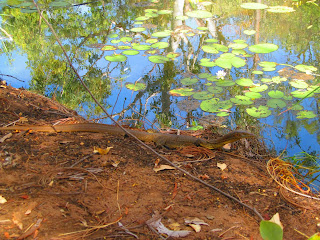
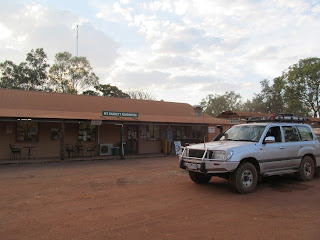














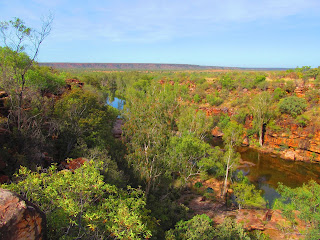













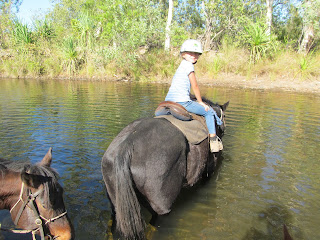








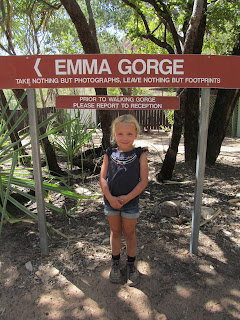



Thanks again for sharing your adventures & all the beauty you have seen oxo
ReplyDelete